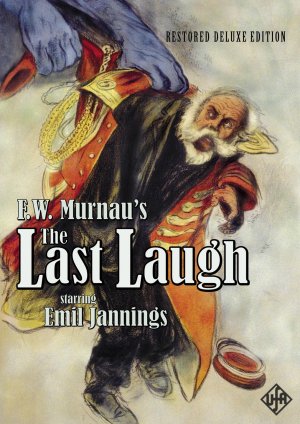Director: F.W. Murnau. UFA.
SILENT

Producer: Erich Pommer. Writer: Carl Meyer. Camera: Karl Freund. Music: Werner Schmidt-Boelcke, Giuseppe Becce, Karl Ernst Sasse. Florian C. Reithner (1996 reissue). Sets: Edgar G. Ulmer.
Emil Jannings, Maly Delschaft, Max Hiller, Emilie Kurz, Hans Unterkircher, Olaf Storm, Hermann Valentin, Georg John, Emmy Wyda.
SYNOPSIS
Physically unable to carry the burden of his duties any longer, a hotel doorman (Jannings) is given a less taxing but more menial position as a bathroom attendant. Embarrassed and humiliated that his neighbours will no longer see him for the preening peacock that he is, he steals the coat of his uniform in a bid to pull the wool over their eyes. But his peeping in-law Kurz spots the new man on the job and tells his neighbours.
REVIEW
One of the crowning glories of the golden age of expressionistic film-making in post World War I Germany (expressionism being an artistic movement where, to put it simply, the artistic product is exaggerated wildly for emotional effect, to evoke moods or ideas), this is a simple story about human pride and human failings that is, correspondingly. distorted onto a lavish, multi-million DeutschMark canvas.
Based on Nikolai Gogol’s anti-militaristic novel The Coat, it is turned by expressionist supremo Murnau into a visually stunning, gripping tale that hits its mark despite, or perhaps because of, Murnau’s decision to not use a single title card to explain the action. Silent movies had progressed to such a level of stylistic sophistication that written descriptions were no longer necessary. This addition (or subtraction) was not repeated in other films of the period though.
Among the most notable features here is the admirable use of mobile camera work that really liberates the action; the moment where the porter imagines the Atlantic Hotel is going to topple down on him and the night watchman’s torch that seems to focus Jannings’ desperation.
All in all, Murnau created perhaps the most modern and accomplished of silent films up to this point.
Narrative wise, the story is strong when it comes to exploring themes of how the importance placed on uniforms can envelop people and leave them to assuming a role dictated by position and it is interesting to see how Murnau positions other people in relation to the obsession Jannings has with his coat – his neighbours protect it from the dust they beat out of their carpets. It doesn’t require a huge leap of faith to link this theme to the still very recent memories of WW1 and it is prescient in terms of what would happen only a decade later in Germany under Nazi rule.
Interesting to note that the porter/janitor character is unnamed throughout. In fact, every character is defined by their function or relationship to him. This impersonality is a little unsettling, as if Murnau is refusing us identify with his characters on a personal level, but it concentrates the mind a little more on what people are doing rather than who is doing it.
There was no other face of the silent era that was better constructed to convey angst, desperation and dismay at the vicissitudes that life can throw at us that Jannings. He always excelled in roles that required him to suffer nobly as opprobrium is heaped upon him and, here, his terrified, kitten-like eyes are almost painful to watch. It is a performance of commendable physicality – bolt upright and proud when we first see him, saluting his neighbours and fastidiously attending to his appearance and then crook-backed and shifty as the film finishes.
Quite why Murnau then had to ruin all of his good work with a completely disposable epilogue is another matter, but The Last Laugh is still a grand piece.

